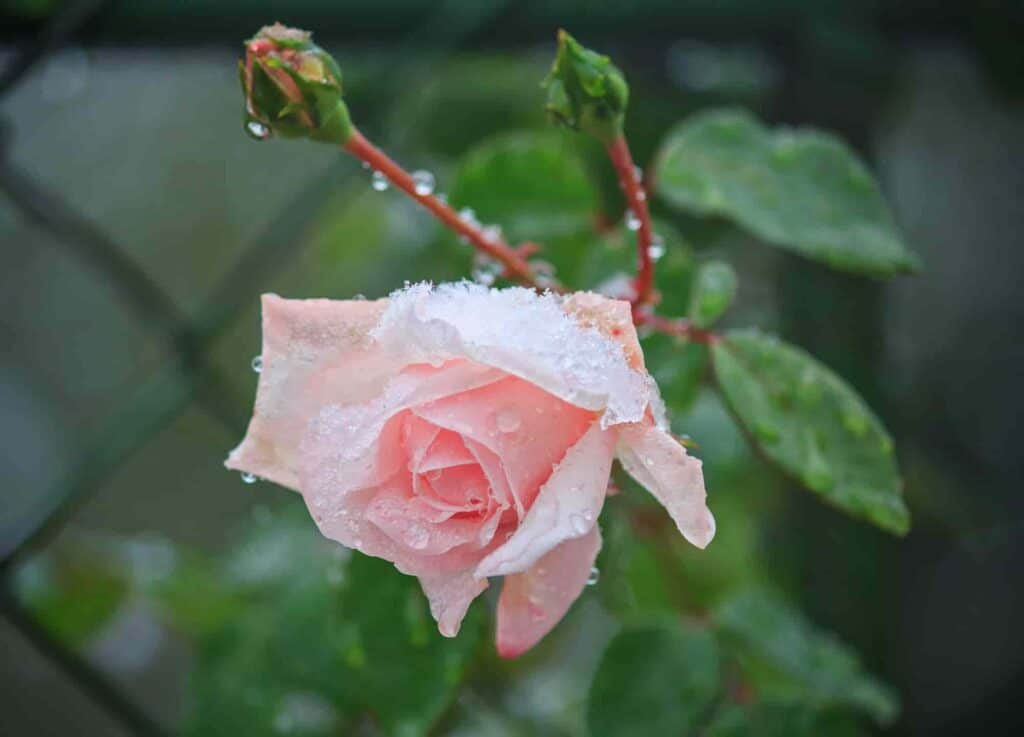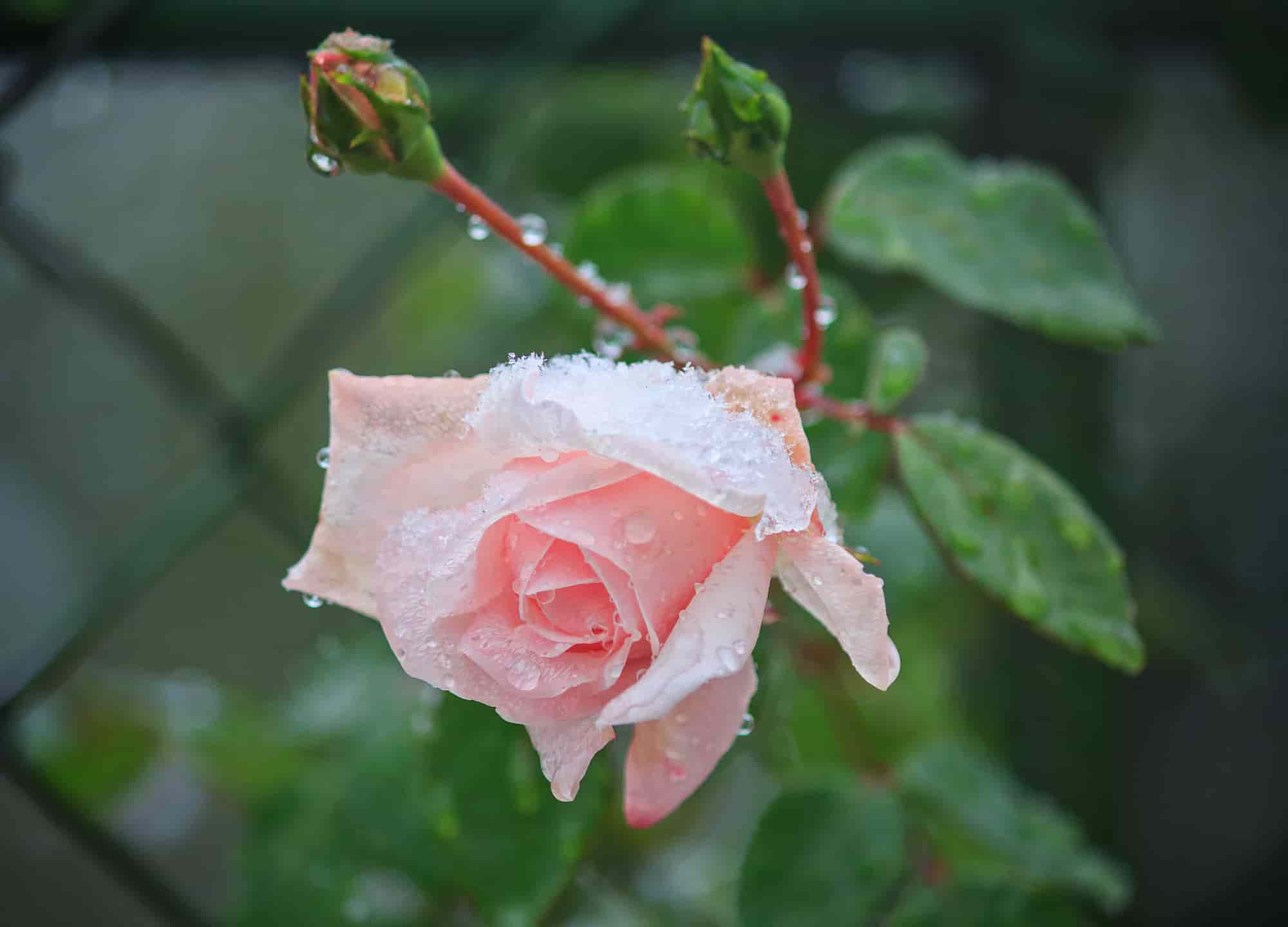The quality and the quantity of the roses you will enjoy next June are determined largely by what you do with your shrub rose bushes during the next few weeks.
If drought or neglect has left your bushes in poor condition, your effort to bring them back to normal should begin now.

Even bushes in good condition at the end of the summer will respond better next spring if given some extra care now.
Provide Sufficient Plant Food
The first step is to make sure that growing roses have sufficient plant food.
If, despite good care and ample moisture during September and October, they have not grown and flowered satisfactorily, chances are they are not getting enough to eat.
However, if roses have been growing vigorously, feeding can be postponed until spring.
Fertilizing Roses
Of course, you’ve been told or led that you shouldn’t fertilize roses later than August 15.
That general statement is only half true and applies to “complete” plant foods high in nitrogen which might stimulate new growth that wouldn’t mature properly before freezing.
But phosphorus and potash act much more slowly than nitrogen, and a good generous application of superphosphate (6 to 8 pounds per 100 square feet) and wood ashes (3 to 5 pounds per 100 square feet) will be decidedly beneficial.
Pre-Winter Pruning
Now is a good time, too, to take out any plants that have not proved really satisfactory after a two-year trial or that have died.
New plants can be pinned in anytime until the ground freezes. Next comes the pre-winter pruning.
As soon as frost has destroyed the last flowers and buds, remove them and also cut back by one-third their length any tall growths that might whip around in winter winds.
Cleaning-Up Is Essential
Ideally, these and any thick, broken, diseased, or otherwise undesirable parts should have been removed in August or early September while there was still time for the wounds to callus over completely before frost.
A thorough clean-up is essential. Carefully rake up with a small hook or a finger weeder fallen leaves, twigs, prunings, etc.
Remove any weeds or grass, being sure to get out the roots. The debris is best collected in a basket or bag as the work progresses and then burned.
Spraying In Last Fall
Now we are ready for the last fall spraying, which is to disinfect both plants and soil.
As we need not worry at this time about spray injury to foliage and tender new growth, a very concentrated spray is employed 1 part lime-sulfur to 9 parts water – to thoroughly cover the bushes and the ground around them.
The next step is to cover the rose bed with its winter blanket. Hilling up around the base of each bush is the accepted and safest method.
Garden loam or better still, sifted compost—is brought in and heaped or “hilted” around and over the stems to a height of 6” to 12” inches depending on the severity of the winter weather to be expected.
Six inches is usually adequate for the vicinity of New York City. However, when extremely low white temperatures are encountered, twelve inches may be needed.
The compost for hilling is always brought in and added to the soil already in the bed, as scraping up existing soil in the bed for this purpose might expose rose-growing roots to winter injury.
Removing Of The Mound
The extra blanket of earth protects the area where each bush has been budded on the under-stock and the stems immediately above it.
In spring, when the mounds are removed and worked into the beds, new growth starts readily from the stem buds, which have been cozily protected all winter.
In locations where only mild freezing is the rule, mulches of evergreen boughs are rock wool, or other mulching material may be substituted for billing. These, however, are not applied until after a hard freeze.
Tree Roses
Tree roses, because of their tall bare trunks, are subject to winter kill and breakage and therefore need special winter protection.
These are usually wrapped in a heavy covering of straw supported by stout stakes and covered by burlap.
Encasing Tree Rose
An easy method I have found is to encase each tree rose in a wrapping of three small Christmas trees, a load of which can be purchased for a nominal sum after the holiday.
If the trunks are firmly inserted in the ground around the rose standard and the branches bound about it with strong cord, no better protection could be asked for.
Less unsightly than straw and burlap, the little evergreens also provide welcome shelter for birds, especially in snow and sleet storms.
Climbing Roses
Like bush roses, climbing roses should not be heavily pruned in late autumn, but any neglected wayward growth may be removed along with dead or over-mature wood that may be interfering with vigorous new growth.
Very long canes to be saved should be securely tied so that they will not be broken by wind and ice.
If such branches of large-flowered rose climbers are trained and tied in a horizontal or at least slanting position, many blooming sprays will start from them in spring.
Tall vertical canes often produce bloom only near the top.
Where extremely cold winters are to be expected, climbers of doubtful hardiness may be laid down, pegged to the ground, and partially or completely covered with loam or straw.
Old rugged climbers have far too heavy for such treatment and do not need it.
This form of winter protection may save climbing hybrid teas and such varieties as High Moon and Mermaid in severe climates.
44659 by F. F. Rockwell
